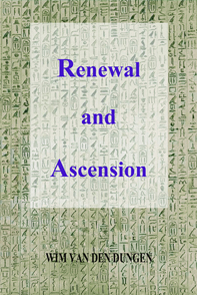|
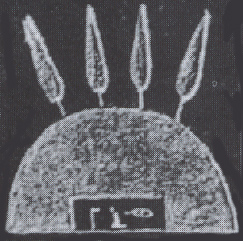
see the god
in the hall underneath the trees the Egyptian
temple
"In ancient Egypt,
festivals were celebrated (completely or partially) in temples. These
were pure and sacred places, where (some) humans could approach the
deities. Thus, it is very important to be clear about the character that
the temples possessed as single entities separated from the world. This
special character is acquired in the mythical foundation, because they
are located in the lands that first emerged."
Serrano,
2002, p.1.
No other ancient
culture constructed temples in such number. Beyond the physical stone of
these temples,
"we
may still sense much of the symbolic nature of these structures, the
deeper reasons for their construction."
(Wilkinson,
2000, p.6).
They have been described as mansions
of the deities, models of Egypt and the universe, focal points of
worship, portals to the divine, islands of order amid the ocean of
chaos, spiritual engines etc.
In functional terms, there were two types of temples : (a) the houses of the gods,
serving their patron deities and (b) those serving the royal cult of the
"son of Re" (before -for his Sed Festivals- and secret rituals and after
he died, i.e. in his mortuary cult). Throughout Egypt's history, a thick
curtain of silence was drawn between the sacred, pure temples and the
outside, profane world.
"Never
go about revealing
the rituals You see, in all mystery, in the temples."
Chassinat,
1928, p.361, line3 - temple of Edfu - Late Period.
The
earliest traces are Predynastic (ca. 6000 - 6500 BCE - Nabta Playa),
whereas the last temple (of Isis at Philae) was closed by Emperor Justinian in 535
CE (Theodosius in 384 CE had decreed the closing of the temples of
Egypt, officially ending the Pagan Era).
"Within the
walls of most of these monuments, sanctuaries and treasuries, offices
and palaces, slaughterhouses and schools might be found. Not only were
many of the religious complexes centres of government, economy and
commerce, but also within these temples ancient science and scholarship
thrived and the nature of existence itself was pondered by generations
of learned priests."
Wilkinson,
2000, p.7.
Egyptian versus Greek initiation
Egyptologists like Morenz, Piankoff,
Mercer, Frankfort, Faulkner, Assmann, Hornung or Allen
have good reasons to stress the difference between the Greek and
the Pharaonic perspective on initiation (from the Latin
"initio", introduce into a new life). The Egyptians maintained a
series of rituals aimed at
"a constantly renewed
regeneration" (Hornung,
2001, p.14). At best, the Greeks
induced the point of death in order to glimpse into its darkness, to
"see the goddess" and renew. But they had no "science of the Hades" as
in the Amduat. The active continuity between life and death found
in Egypt, contradicts the closed and separated interpretation of the
Greeks, fostering "escapism" (the "body" as a "prison" out of which one
needs to escape). In Egypt, no "new" life was necessary. Death
could bring "more" life. For both life and the afterlife
depended on identical conditions : offerings ; either directly to the deities through
Pharaoh or indirectly to the Ka of the deceased. If dualism fits the Greeks,
triadism is Egyptian.
In their exclusive funerary interpretation of the
religious literature of Ancient Egypt (Pyramid Texts, Coffin
Texts, Coming out into the Day, Amduat, Book of Gates),
these great scholars evidence a Hellenocentrist prejudice. Although the
Platonic philosopher "preparing for death and dying"
is like the
initiate of the Eleusinian mysteries (cf. Phaedrus and Phaedo),
and may come to the point of death to see into the invisible
(spiritual) worlds, he knows he will never find wisdom in all its
purity in any other place than in the next world ... So,
according to these authors, sustaining the Hellenistic approach of contemporary
Egyptology regarding religious experience in Ancient Egypt, the initiatic,
this-life experiences of the king,
of his
priests and of his worshippers, found in the religious text and on the monuments of
Egypt, do not reflect direct spiritual experiences, but are imaginal
constructions and wishful thinking about the afterlife. The dogma being : Ancient Egyptian
religion was funerary and mortuary. This position is rejected. It is not
because a text is found in a tomb that it is necessarily funerary. In
Egypt, Pharaoh encountered the deity "face to face" every day. He was a
god on Earth, in the Duat and in the sky. His energy had no limitations
and with it he sustained creation by offering the right order of nature.
There was no question of initiation being linked with the separation
caused by physical death. Physical death (of Osiris) was the gate to a
resurrection for the benefit of the living (Horus). But the living king
(Horus) could also ritually die (as Osiris) to resurrect (himself and
Egypt).
"As we have already seen, it is perfectly feasible
for the same pyramid to have been use both for the Sed festival, 'secret
rites' and then subsequently as the tomb of the king."
Naydler, 2005,
p.109.
Indeed, the validity of an exclusive funerary interpretation of the
Pyramid Texts (or for that matter the complete corpus of
religious texts, such as the Coffin Texts, the Book of Going
out into the Day and the Amduat), popular in egyptology the
last 50 years, has to be addressed : is there a mystical dimension or
direct experiential contact with the divine beyond the first three
studied by Egyptology (Assmann, 2002) ? To wit :
-
the cultic
: the local, political residence of the deities,
either as belonging to a particular place and/or as state deities
functioning as symbols of the collective, political identity ;
-
the cosmic
:
the emergence, structure & dynamics of the sphere of their
action ;
-
the mythic
:
the sacred tradition, or "what is said about the gods", their
cultural memory as set down in myths, names, genealogies etc.
-
the mystic
: the direct experience of the deities or the
objective spiritual realities encountered by the divine king, his
priests and worshippers.
In the context of the New Solar
Theology in general and
Atenism in particular, the question
whether Egyptian religion had religious subjects besides the dead has
already been answered affirmatively, whereas the
role of Osirian initiation was
touched upon (cf. the Osireon). Akhenaten's return to the "pure" form of
Solar worship allows us to work out the inner dynamics of the this-life
mysteries celebrated by Pharaoh, "mysticism" being defined as the
direct experience of
the Divine. Atenism rejects the "hidden"
and the "dark", and so cannot exist together with Osiris and Amun. It
eliminates the "hidden" side of Re, returns to the exclusive worship of
the lightlands of the horizon of both East and West (cf. Ra-Horakhety),
and rejects all possible netherwordly interpretation by eliminating the
Duat and bringing the sky on Earth, namely in Akhetaten, Akhenaten's City
of the Aten. This is the Solar economy pushed to its limits. Its sole
mooring-post being the king.
And the people ? They secretly continued to worship Osiris, even in
Akhetaten, and likely elsewhere. Did they remember the failures of
kingship (namely at the end of the Old Kingdom) ? Did they disbelieve
Akhenaten ? If so, they still obeyed. Perhaps, for their own hearts, the
certainty of a good place in the kingdom of Osiris gave greater comfort
than the "new" heaven of Akhetaten ? Indeed, the second-best, Lunar heaven
of the commoners had not lost its alluring power. But, touching Osiris,
the issue of the mystic dimension is "demotized" : how could commoners
directly experience and "see" the deities ? For
Moret (1922), the mystery in Egypt
revolved around the concept of "voluntary death", experienced before the
actual physical death of the body. This "dead posture" preludes spiritual
rebirth or "peret-em-heru" : going out into the day ... For
Wente (1982), the New Kingdom Amduat
and Book of Gates bring "the future into the
present", so that rebirth "could have been
genuinely experienced in this life now". And this, most likely
through festivals, pilgrimage & personal piety. In these latter contexts,
Osirian faith allowed non-royals to have direct spiritual access to the
Duat, the world of magic and of the dead. The Books of the Netherworld are
usually very explicit about this, but Egyptology has yet to take them
serious.
"He who know these words will approach those who
dwell in the Netherworld. It is very very useful for a man upon Earth."
Amduat, concluding text of the
Second Hour.
"The mysterious Cavern of the West where the Great
God and his crew rest in the Netherworld. This is executed with their
names similar to the image which is drawn in the East of the Hidden
Chamber of the Netherworld. He who knows their names while being upon
Earth will know their seats in the West as a contented one with his seat
in the Netherworld. He will stand among the Lord of Provision as one
justified by the Council of Re who reckons the differences. It will be
useful for him upon Earth ..."
Amduat,
introductory text of the Ninth Hour.
How can these texts not point to a this-life occult knowledge ? And once
we acknowledge the presence of a mystical dimension, we beg the question
of how to operate the magic ? Is there a particular series of rituals
enabling one to experience the objective spiritual realities
behind three thousand years of spirituality today ? Of course, the
first thing to do is to lift the funerary restrictions put on the
available corpora. Although found in tombs, they move beyond
funerary concerns (cf.
Wente, 1982), but also show us an
initiatic and experiential register, albeit in ante-rational terms. But,
in order to clarify our categories, we first will have to distinguish
between psi-experiences (parapsychology), occultism (knowledge of the
invisible worlds) and
mysticism (direct experience of the
Divine). Although in the earliest forms of meta-nominal experiences
(outside the ordinary realms of sensoric awareness) these phenomena merge
(cf. Shamanism), I do avoid adjectives as "shamanic" or "shamanistic" (cf.
Naydler, 2005), and prefer "ecstatic",
which is more neutral and devoid of the historical connotations implied by
Shamanism (the art & science of controlled trance). In Ancient Egypt, the
variety of ecstatic experience covers personal piety (offerings, prayers,
festivals, mystery plays), magic (psi-events), the occult (entering and
leaving the Duat) and mysticism proper (the spirituality of the king and
his high priests, meeting the deity "face to face" or transforming into
one). I definitely strongly disagree with my most rewarding source of
inspiration, Erik Hornung, who wrote about the Egyptians :
"... any sort of ecstasy appears
quite alien to their attitudes."
Hornung,
1986.
Elsewhere, the reader may find my
epistemological survey of
mysticism. In the context of this paper,
the term "ecstasy" (from the Greek "ex" or "out" + "stasis" or
"standstill" ; "statikè" or "art of weighing") is defined as the class of
events pertaining to rapture, the ravishing experience of sublime delight,
bliss and joy, accompanied by very strong emotion and (stages or stations
of) trance. One moves outside the "nominal" ego and "enters" the realm of
a Higher Self, i.e. a witnessing focus of consciousness allowing for the
direct perception of objective spiritual realities, hidden from ordinary
consciousness as is dreamless sleep from waking (so far indeed for
Socrates to compare the former with physical death). This realm can
directly influence the immediate context in which events emerge and may be
classified as psi-phenomena (cf. strong telekinesis and remote viewing),
the manipulation of invisible realms of reality (cf. the occult, magic and
necromancy) and the direct experience of the objective spiritual realities
invoked by the religions of humanity (cf. mysticism in all its forms). The
presence of magic, the study of the Duat, Temple ritual and funerary
concerns highlight the highly ecstatic naturalism of the Ancient
Egyptians.
Egyptian initiations, unlike the Greek, were not meant to release the
applicant from the solid chains of the world and its destiny, quite on the contrary.
The initiate entered the invisible Duat at will and was free as a bird to
stride and experience. He also returned, completing the standard cycle of
human spirituality en vogue since the Cro-Magnon. Although the
Egyptians, like other cultures contemporaneous with Pharaonic Egypt (like
the Minoan, Mesopotamian, Hittite), understood that plunging into the
spirit-world revitalized consciousness, they particularly focused on
regeneration both in this life and in the afterlife. This happened by an
"embrace" of objective spiritual principles projected upon recurrent
natural cycles (like Horus and Osiris in the myth of Osiris, or the Ba of
Re and Osiris in the Solar myths).
The verb
"bs" ("bes") has two nuances : inductive and
secretive :
-
inductive : to introduce, bring in, install ;
-
secretive
: to initiate, reveal ;
What is
revealed should never be said. It is a secret, or "bs"
again, but with one more determinative added (that of a papyrus scroll,
indicative of words related to writing and thinking). The "secret of
secrets" was the secret image of the deity or "bsw"
("besu").
"I
am a priest knowledgable of the mystery,
who's chest never lets go what he has seen !"
Chassinat,
1966, pp.11-12.
With the verb "bes", Middle Egyptian points to the
Egyptian initiate as someone who had seen the hidden image of the deity "face to
face", triggering a secret experience.
Transformed, he or she had received more life-power, and had become more
complete. The Egyptian initiate was prepared for the afterlife. He had
faced judgment, had been regenerated and transformed on Earth as he
would be in the afterlife.
Clearly then, the "initiates" were
foremost the divine king and those Egyptian priests who belonged to the
higher priesthood.
Only they were allowed to
enter the sanctuary of the temple and perform rituals there (the offering hall, the ambulatory, the inner
sanctum). Only one member of this higher priesthood saw the deity
"face to face", enthroned in its naos at the back end of the
inner sanctum. This high priest was the representative of Pharaoh, the
divine "son of Re" and the "Lord of the Two Lands".
Another word for "secret" is "StA"
("Shtah"), also meaning : "secretive, mysterious,
inexplicable, hidden, hidden away." "Shtahu", in epithets
of divine beings, refers to the mysterious secrets themselves. In Greek,
the word "mustikoi" (root of "mystic, mystical,
mysticism") also means "hidden".
In the Greek mysteries, the
afterlife was depicted as a realm of shadows and any hope of
individual survival
was deemed ephemeral. Nobody escaped destiny, except the deities and the
lucky few elected. The latter "escaped" from the world and its sordid entropic
fate, misery and possible "eschaton" : a world-fire invoked by
these wrathful deities themselves, unforgiving of man's tragi-comical
sins, but able to recreate the world in a whim ! Escape
from this fated comedy was offered through the mysteries. They would erase the cause of the
heaviness of the soul and its attachment to Earth, and end the cycle of metempsychosis, the
successive return of the soul in other physical bodies.
"... what appears in the fifth century is not
a complete and consistent doctrine of metempsychosis, but rather
experimental speculations with contradictory principles of ritual and
morality, and a groping for natural laws : the soul comes from the gods
and after repeated trials returns to them, or else it runs forever in a
circle through all spheres of the cosmos ; sheer chance decides on the
reincarnation, or else a judgement of the dead ; it is morally blameless
conduct that guarantees the better lot or else the bare fact of
ritual initiation that frees from guilt."
Burkert,
1985, p.300, my italics.
The Greek spiritual experience was rational (decontextual). With the end
of the Polis States, a great fear had taken hold. Late Hellenism was flooded
by astral fatalism and Oriental mysteries adapted to Greco-Roman
standards. Demons or deities were invoked to erase a preassigned
fate. If the Greek initiate was deemed "liberated" from the world,
then the Egyptian initiate was "deified" by the world.
The Egyptian initiate was not introduced to get rid
of guilt, break away from the cycle of reincarnation or leave the Earth
without ever returning. Neither did he enter the sanctuary with a
confused concept regarding death. He did not believe life on Earth
was better than the afterlife, and although he might have feared the
"second death" (annihilation of his soul in the afterlife),
the Egyptian initiate had a long-standing tradition of moral precepts
and rituals to assure this would not happen. Indeed, his
initiatoric rituals intended to prepare him for what was bound to
happen in the afterlife. Thanks to a "general rehearsal" of
what would happen, the adept would have no surprises in the afterlife.
Indeed, the laws of life (the deities) were operational in the afterlife
as well as on Earth, and the spirits of the deceased existed together
with the living, albeit on another plane of existence (cf.
hylemorphism).
In the "holy of holies", the highest Egyptian initiate (the
high priest of the temple) came "face to face" with one of the
divine hypostases of nature's elements & forces, namely the deity of
the temple in its central shrine.
Only Pharaoh or his direct representative could offer Maat to the deity
and thus return the given life to its source (to receive new life). This
key ritual in Egyptian monarchical religion, is not focused on reception
& the receiver (cf. "to receive in order to bestow" in
Qabalah), but on the source of both (cf. "to present in
order to receive"). On an individual level, this was a
transforming experience insofar as the person was chosen from the higher
priesthood. In that case, the confrontation "face to face" left a tremendous
imprint on the heart of the individual.
"(Akenaten) :
The words of Re are before thee, (---) of my august father,
who taught me their {essence}, (...) them to me. (...)
It was known in my heart,
opened to my face, I understood (---)
(Ramose) :
"Thy monuments shall endure like the heavens, for thy duration is
like Aton therein. The existence of thy monuments is like the existence
of the heavens ; thou art the Only One of {Aton}, in possession of his
designs."
Breasted,
2001, §§ 945-946 - tomb of the vizier Ramose - original lost - Akhenaten
justifying Atenism to Ramose by referring to his personal & exclusive
mystical experience - Beasted notes :
"These accompanying inscriptions are
directly below the upper row, depicting the decoration, and belong with
a lower band connected with the same incident. They are only in ink and
very faded ; I believe my copy of them is the first made. They have
never been published."
(p.389)
As a temple ritualist, the Egyptian
initiate, in order to be transformed and "see" the deity directly, never left his
physical body behind in
a passive, trance-like state (compare this with what happens in the Poimandres
or in
Classical
Yoga). Fully awake, he enters into a deeper, more profound, mysterious layer of reality and
contacted this plane directly, alone and without intermediaries, except
for the doubles and the souls. His
ritual actions made his body fully participate in this experience.
The contrast with the Greek mentality is marked : the Greeks had assimilated a rational distinction between the
conditions of becoming and those of being, between potentiality and
actuality (cf. Plato and Aristotle). In general, matter was perceived as
"gross" and more in tune with the world of becoming. Concepts,
ideas and their contemplation were deemed of a "higher" order,
which meant done for their own sake. Linear order was the standard of Greek
concept realism and the afterlife was envisaged as a gloomy land
of no return, alien to the living.
"The living are not at
the mercy of the dead ; the shades are without force and without
consciousness. There are no ghostly terrors, no imaginings of
decomposition, and no clatterings of dead bones ; but equally there is
no comfort and no hope. The dead Archilles brushes aside Odysseus' words
of praise, saying : 'Do not try to make light of death to me ; I
would sooner be bound to the soil in the hire of another man, a
man without lot and without much to live on, than ruler over all the
perished dead.' In the dreary monotony everything becomes a matter of
indifference."
Burkert,
1985, p.197, my italics.
The regular movements of the planets followed precise geometrical
conditions. These were suggestive of the "perfect forms" of
the world of ideas (or those perceived by the "active
intellect"). Hence, in the Greek mysteries, astrology was used to divinate destiny and fate
("heimarmene" and "ananke"). Magic was addressed as
a means to overcome one's preassigned fate, wiping out unluck, etc.
Finally, theurgy came into being. A decisive release from the forces of
fate & mortality was invisaged by working directly with the Deities.
In Gnosticism, which had many branches, a "special knowledge"
was aimed at. Again the material world appeared in negative,
depreciative terms (cf. evil as "privatio boni" in Neoplatonism
and Roman Catholicism on original sin and the cause of evil).
"And when, by drawing
on repressed or non-Greek traditions, mysteries began to feed on the
hopes of individuals with universal speculation and sought to overcome
the chilling isolation of man in death, this was for a long time more a
complement than a dangerous rival to the Greek system."
Burkert,
1985, p.203.
In the Egyptian conception, commoners sought a happy
life to satisfy their souls (cf. the
Discourse
of a Man with his Ba),
while priests were consecrated in (local) induction rituals (leaving the
"ultimate" experience to the high priest). Is it
possible the higher priesthood also participated in the Osirian mysteries
of death and resurrection, held in
major temples of Egypt, like those of Abydos, Busiris and Karnak ? Such
ritual activity would prepare them for the afterlife and transform them
into "initiates" on Earth (adepts "justified"
while alive) ?
"Follow
the god as far as his place,
in his tomb which is found at the entrance of the cavern.
Anubis sanctifies the hidden mystery of Osiris,
(in) the sacred valley of the Lord of Life.
The mysterious initiation of the Lord of Abydos !"
Griffith,
tombe I, 238, lines 238-239, ca.XIIth Dynasty.
But
Egyptian and Greek initiations had this in common : both involved a
confrontation with a symbolical death, followed by a new state of
being alife.
"to
die, that is to be initiated"
Plato
funerary
literature
Although the first mortuary corpora (Pyramid Texts, Coffin
Texts & Book of the Dead) have distinct literary features, these
utterances or spells have their recitation accompanied
by rituals. Some Egyptologists conjecture that
during the funeral, rituals took place in the various chambers, corridors
and courts through which the procession passed on its way to the pyramid
(Schott, 1950).
Indeed, the tomb of Unis
displays this care for rhythmical, procession-like spatialization, which -if we may believe
the evidence from the Late Period- continued to be an essential part of
Egypt's temple ceremonialism (cf. the walls of the Temple of Horus at
Edfu). The dynamical notion evoked by a procession, is symbolical at
many levels : it is the Nile, the eternal movement of Re in the sky,
dynastic succession, the
ordered sequence of existence and the principle of the adjacent probable
(each figure focused on the one ahead).
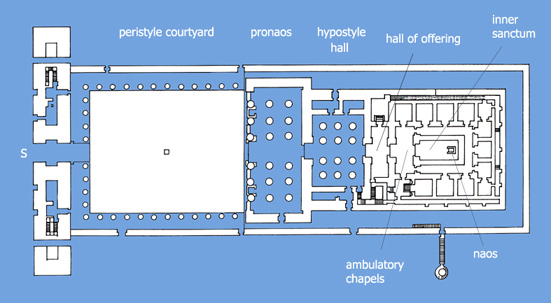
The Temple of
Horus at Edfu
In the Coffin Texts, as well as in the so-called Book of
the Dead, remnants of "this life" ritual activity may be found. The
Book of
Coming out into the Day, as the latter corpus was named, has been called
the "Egyptian Bible". Not for any literary resemblance with
the historical Bible (there is hardly any to none), but because
it was so dominant in funerary archeology, literature, anthropology & Osirian
theology.
In the phrase "prt m hrw", the crucial word "prt",
"coming out", or "going forth", also implies a ritual procession, an
appearance of the deity (like the Heliacal rising of Sothis - Sirius) by
day ("m hrw").
Chapter 17, a synopsis of the whole Peret em Heru, starts with
the following enigmatic words :
"Here
begin the praises and glorifications,
going out and in the domain of god,
having benefit in the beautiful West,
coming our by day,
taking any shape he likes,
playing at Senet, sitting in a booth,
and coming out as a living soul.
After he has arrived in port,
Osiris, the scribe Ani, said :
It is beneficial to him
who does it on Earth.'"
Book
of the Dead
Chapter 17 (Ani & Nebseni), my italics.
Already
during his lifetime did the archetypal Ani praise and glorify god and
his company. It seems unlikely some of these texts would not have
been used in certain priestly rituals (cf. the "great mix" of
ante-rational cognition), although most spells
seem to serve the purpose of
providing & protecting the deceased (or of Pharaoh during the Sed
Festival ?). Perhaps
some scenes were enacted (in ante-rational memorization - cf. the
vignettes that accompany certain spells). That some spells were also
intended for the living is however obvious :
"As for him who
knows this chapter, he will be a worthy spirit in the domain of god, and
he will not die again in the realm of the dead, and he will eat in the
presence of Osiris. As for him who knows it on Earth, he will be like
Thoth, he will be worshipped by the living, he will not fall to the
power of the king or the hot rage of Bastet, and he will proceed to a
very happy old age."
Book of the Dead,
chapter 135.
induction versus initiation
Admission to priestly office was based on hereditary rights,
cooption, purchase, royal appointment and induction. The induction
rituals, unknown in details, seem to have implied a presentation in the
temple, purification, anoitment of the hands and beholding the deity.
"I was
presented before the god, being an excellent young man while I was
introduced into the horizon of heaven (...) I emerged from Nun, and I
was purified of what ill had been in me ; I removed my clothing and
ointments, as Horus and Seth were purified. I advanced before the god in
the holy of holies, filled with fear before his power."
Sauneron,
2000, p.48 - statue - Cairo museum 42230.
Because induction involved the assumption of an office in a
particular temple, it was a form of initiation, for it implied being introduced
to a new kind of religious activity. However, did it aim at
transforming consciousness ? Was this initiation also soteriological
besides being consecrational ?
It is clear induction must have
had an impact on the person consecrated. Perhaps the increased proximity
to the deity automatically conferred certain new states of
consciousness, a more deeper prehension of the divine ground of
existence ? Indeed, after consecration, the new priest would have access
to the most remote, secret and darkened areas of the temple and at times
witness the presence of the deity from very nearby. It is impossible
this experience did not affect the spiritual awareness of those
installed. Hence, at every "level" of the temple hierarchy, it
is fair to assume that
consecrational initiations took place.
But induction was foremost aimed at assuring the continuity of the
service payed to the deity (or the deceased). That it had an impact on the consecrated
priest does not seem to have been the primary target, although it surely
must have been a welcome
side-effect. Did Egyptian religion develop "mysteries" which had a
soteriological aim, i.e. which had the sole aim of -after having being
performed- transform the consciousness of the priest permanently ?
We know
"seeing" and "being near" the statue of
the deity was also the main event when popular festivals were organized.
During these
popular manifestations the statue of the deity was moved around, either
in the temple or to pay a visit to another deity (cf. the Opet
festival). During these processions, commoners praised, worshipped and
prayed. Being near to their deity enabled them to make their concerns
heard and solved (cf. like the trance of enthusiasts glimpsing their
idol, whether a pop-star or the Pope).
"Such processions were anything but rare. The religious calendars
preserved in several temples demonstrate that according to the season,
each month contained five to ten outings of this sort, devoted to one or
another of the deities of the place. The route would vary according to
the destination of the procession and the temple where the night was to
be spent."
Sauneron,
2000, p.95, my italics.
Osirian initiations ?
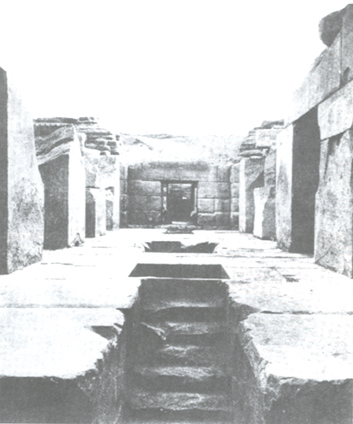
the Osireion
(the roof has gone)
Abydos - XIXth Dynasty
The original
temple of Osiris in Abydos is destroyed. It has been suggested the
construction erected by Pharaoh Seti I (ca. 1290 - 1279 BCE) in the XIXth Dynasty is
a copy of this original, and has been called "the Osireion". Although
supposedly a cenotaph of Seti I, later graffiti suggests it was dedicated
to the cult of Osiris (cf. "the secret place of the netherworld",
"Hail to thee, Isis, in the place of birth !"). Its architecture and
inscriptions underline this.
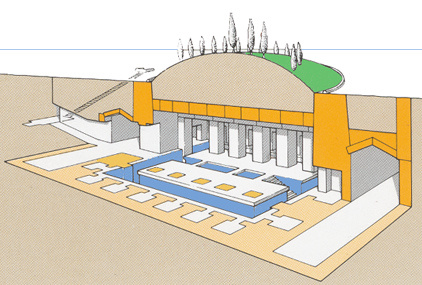
Osireon
(after
Wilkinson,
2000, p.36)
The construction
was originally completely subterranean (underneath a hill with trees) and
accessed via a long (128m) corridor (decorated by Pharaoh Merneptah on the left
wall the Book of Caverns and on the right the Book of Gates),
which gave access to a large hall filled with water. In the middle of this basin
emerges a rectangular island bordered by heavy granit pillars, to which two
staircases grant access (while there is no staircase to enter the basin).
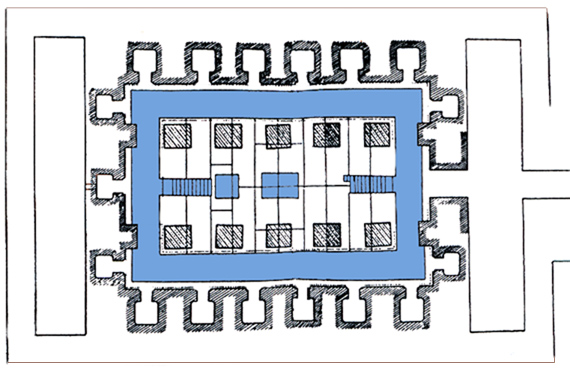
Osireon
(after
Frankfort,
1933, plate II)
Did
the two rectangular cavities hold the "sacred image" of Osiris, his
bark, head & funerary bed ? On the Eastern side of the construction is a
large, empty rectangular room (like those found as chapels in the Old Kingdom
Saqqara tombs).
"(the
ritual), I know it,
for I have been initiated into it by the Sem-priest,
and I have not spoken to anybody,
neither repeated it to the god(s)."
Coffin Texts,
spell 156.
We conjecture (together with
Stricker
and
Guilmot)
that between the popular, festive "seeing" and the sacerdotal
"deification" (of the high priest "face to face"
with his deity), a soteriological (salvic) Osirian initiation existed.
In it, the higher priesthood was confronted with the passion,
restoration and resurrection of Osiris, the popular Egyptian ecstatic
par excellence : murdered, resurrected and Lord of Dead and the magic of the
night. By
enacting the stages of this myth, the initiate would "consecrate" his own
priestly state and be better prepared for the
afterlife, as well as realize a personal transformation in consciousness
in this life.
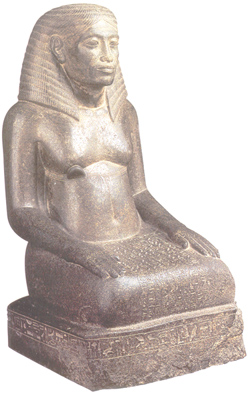
the
architect Amenhotep - XVIIIth Dynasty
"(...),
but into the divine book,
I have been initiated.
Of Thoth, I have seen glory,
and among mystery, I introduced myself."
Statue of
Amenhotep, son of Hapu
This
Osirian initiation was accessible,
ex hypothesi, to the permanent
higher priesthood, as a "consecration" of their task to serve
the light of the deity by offering Maat. Hence, this
initiation had salvic intentions and involved initiatoric mysteries performed in
conjunction with popular festivals honoring Osiris and Isis, popular in all
historical periods. Special chapels were erected for these mysteries at
Denderah, Esna, Edfu & Philae and Osirian mysteries were celebrated
in Busiris,
Karnak and, of course, Abydos, "land of justice, island of the
just, exempt of lies". They allowed the priests to experience the
different phases of the Osirian drama for themselves, including the
restoration and resurrection of the god. In this way, they had been
prepared on Earth for what was going to happen to them in the afterlife.
"(...)
as for the Island of Maat, it is Abydos !"
Book of the
Dead, chapter 17.
An
essential element in this intiation was justification and the
declaration this had happened, so the adept was called a
"maakheru" or "true of voice", a title ordinarily
only given to the deceased after a favorable judgement of the balance
(in the "Hall of Maat").
"(Anubis)
: Numerous are (your) good actions,
(yes) numerous are (your) good actions,
which are placed in the Balance !"
East Wall of
central hall of Osireon
That
this was a title given to initiates, can only be confirmed by
fragments and circumstancial evidence. The vow of silence reigned. But
it
would not be surprising, if such were the case. If so, the
so-called "cenotaph" of Seti I may be understood as the netherworldly
stage for the "grand finale" of the annual Osirian mysteries, as well as
a permanent service payed to Osiris, both events visited by the higher
priesthood of Egypt. But nothing is certain.
"You
shall say to Horus
that I was rejoiced
at his 'voice-becomes-true.'"
Louvre Stela C
10 -
Gardiner,
§ 329.
Several
papyri were found in the tomb of Horsiesis, a priest of Amun-Re and
"Conductor of the Mysteries", who was fifty years of age when
Jesus was crucified. Papyrus Leiden T 32 contains his catalogue of
Osirian initiations or proclamations of piety. In it, standard language
is used (also found on early stelae and papyri) to convey, albeit in an
"idealized autobiography", initiations which he himself might
have experienced during his lifetime in Abydos, Busiris and Karnak.
Egyptologists have argued these experiences are literary fictions.
However, the correlation between the text and certain spatial
characteristics of the Osireion at Abydos, as well as scattered
fragments about such initiations, allow for reasonable doubt.
"You
reach the central hall under the trees.
Near the god (Osiris) You arrive
(the god) who sleeps in his tomb.
His venerable image
rests on his funerary bed.
(Then), in the holy place,
you are accorded (the title) :
Maakheru !
Your body is purified
in Ra-Anedjeti
your whole flesh is purified
in the basin of Heket."
Papyrus Leiden
32 T - IV
A late papyrus
(Papyrus Leiden 32 T) makes it clear that three fundamental
events were enacted : justification (Judgment of the Balance), rejuvenation
(Sacred Lake) and illumination (Opening the Doors of Heaven).
continuous ritual
Life was the cornerstone of Ancient Egyptian theology and
philosophy. Life was deemed to be the origin of order and not vice versa. The creator
evolved himself because of the activity of his life in the primordial
egg hidden in the limitless waters. Life is the active polarity of
limitless inertia, darkness and chaos. It is chaos reversed by what it
harbored as absolute complement of itself. When the cosmic egg
hatches, Shu, the god of life, springs
forth together with order, his spouse.
Light (Atum), Life (Shu) and Order/Moist (Tefnut) were the first generations
of gods.
"I
adore your majesty with choice expressions and prayers,
that magnify your prestige in all your great names
and in all the holy forms of manifestation,
in which you revealed yourself in the first moment."
the morning
invocation at the quaters in the temple of Edfu
The cult of Re is
fundamentally a diurnal cult of life, whereas Osiris is the nocturnal
cycle (the regenerative power of the netherworld, of sleep, dreams and
death). Life and order were in the company of the
creator before anything else was born, but life was first, most active,
airy & verbal.
Let us distinguish between different cycles of
rituals :
-
Diurnal and Nocturnal rituals
: the rehearsal of life : the hymns to the
hours, in the books of the day and the night, refer
to the temple liturgy executed every hour of the day and the night
in the major temples of Egypt for thousands of years. These rituals
were orchestrated by the "hour-priests" ("horologoi") on their
watchtowers (the pylons) ;
-
Temple rituals
: of the king (royal
cult) and of the deities ;
-
Festivals
: ca. 10 major festivals a year and
many minor
every month ;
-
Pilgrimages : to major cult centers
like Abydos ;
-
Netherworld rituals
: the rehearsel of the afterlife.
It seems
unlikely a processional & ritual construction as the Osireon
would not have been used for a netherworldy Osirian mystery drama. As no
other evidence of the sort of papyrus Leiden 32 T has (yet) been found,
no final conclusions are at hand. But even if these Egyptian initiation
rituals are historical (which to me seems likely), they differ from the
intent of the Greek mysteries and should neither be confused with Hermetic and other
highly syncretic rituals (like the cult of Serapis). In these latter ceremonies, native
Egyptian thought was Hellenized and modified to satisfy the Greek
"noetic" mentality.
|

